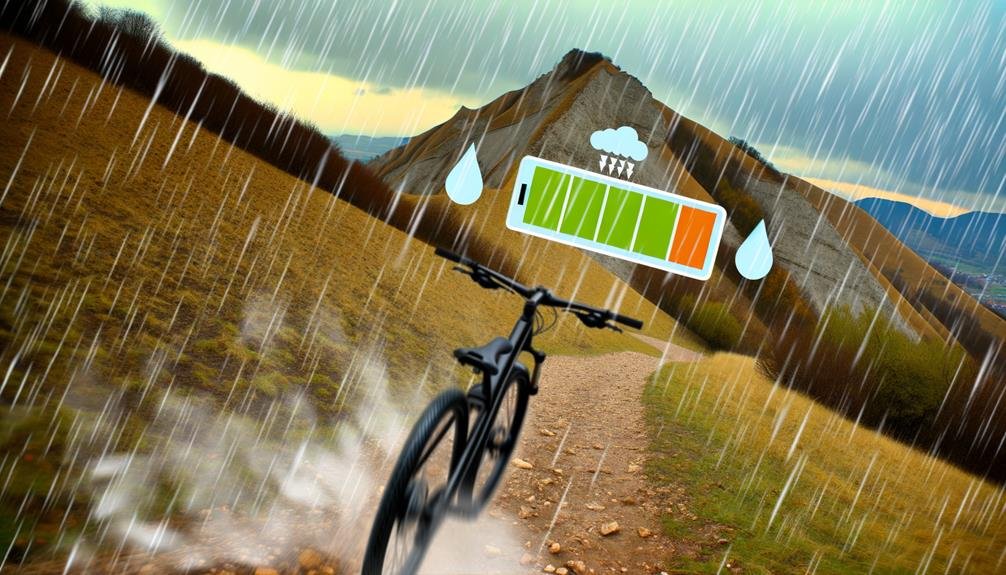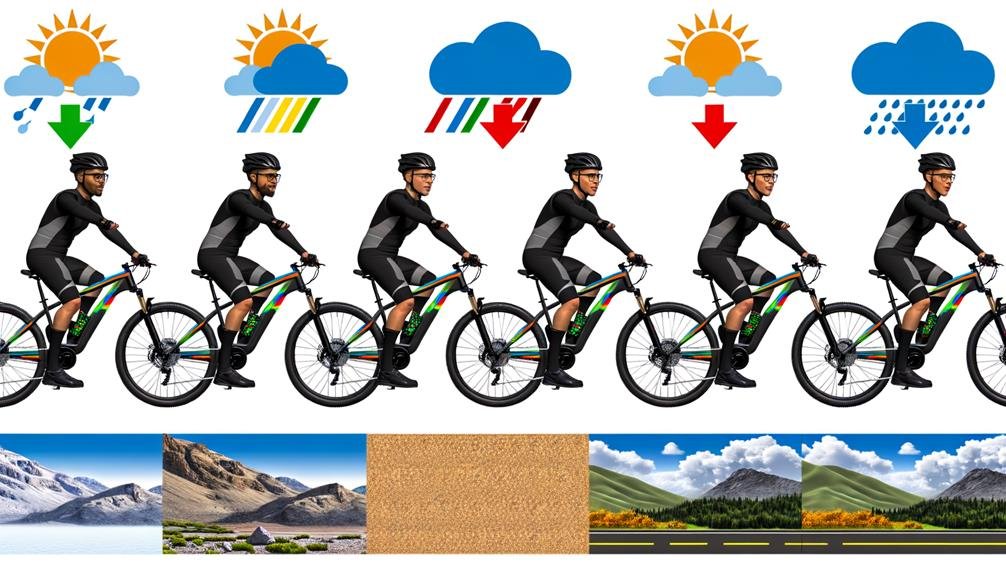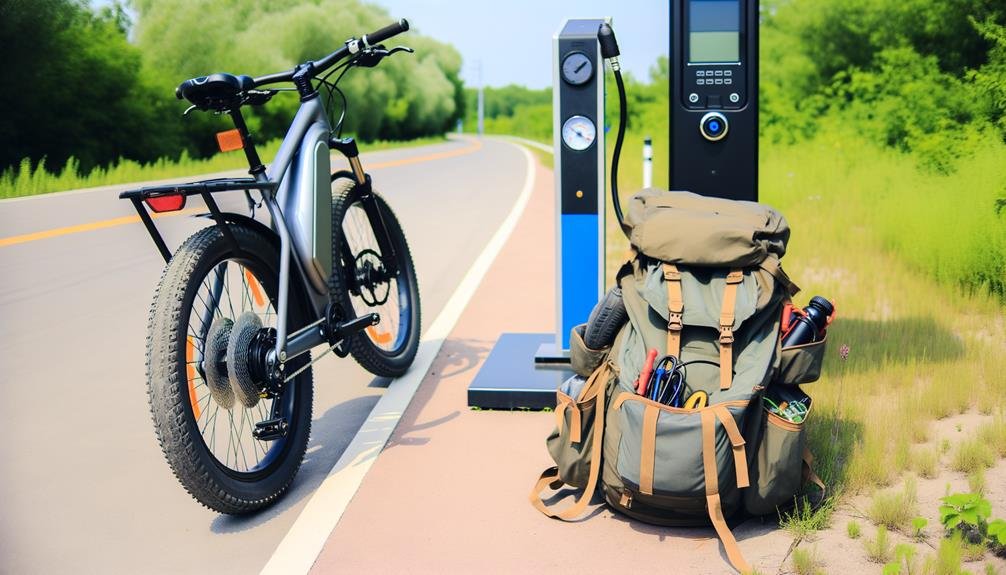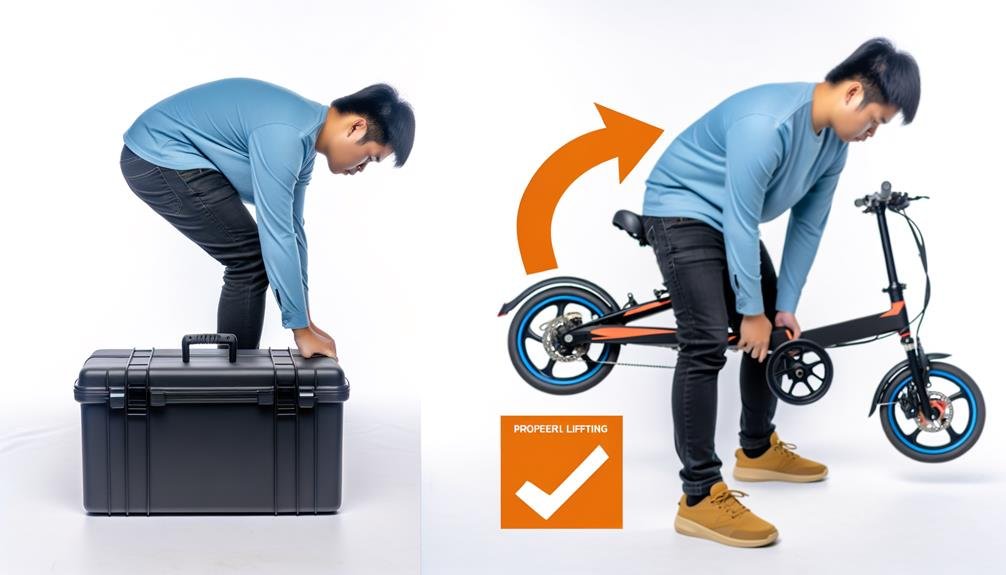Charles Miller is a veteran bike enthusiast with over 12 years of experience dealing with bikes as a mechanic. Despite immense love and expertise for...
Did you know that the average range of an electric bike is between 25 to 50 miles on a single charge? However, this range isn't set in stone. It's influenced by a myriad of factors including battery capacity, the rider's weight, terrain, and even weather conditions.
We're here to guide you through each of these components and how they can affect your e-bike's performance. By understanding these factors, you'll be better equipped to maximize your bike's range and optimize your riding experience.
Stay with us as we delve into the intricacies of calculating an electric bike's range.
Key Takeaways
- The weight of the rider and any additional cargo on the bike directly impact the range of an electric bike.
- The type and capacity of the battery, measured in Ampere-hours (Ah) and Watt-hours (Wh), play a significant role in determining the range.
- The efficiency of the motor affects both the range and performance of the e-bike.
- Riding conditions, such as weather, tire pressure, and the number of start-stops, can also impact the range of an electric bike.
Understanding Electric Bike Range
To fully grasp the range of an electric bike, we must first calculate the watt-hours of the ebike battery by multiplying the voltage with the amp hours, giving us an understanding of the battery capacity. This step is crucial in our ebike range calculator. For instance, a 48V battery with 10Ah has a capacity of 480 watt-hours (48*10). This measure of energy capacity allows us to estimate the potential distance we can cover.
However, it's essential to note that many factors affect ebike range. Weather conditions, tire pressure, frequent start-stops, the weight of the rider and cargo, and the equipment used can all influence how far we can ride. Also, the type of battery and motor weight play significant roles. Lithium-ion ebike batteries, popular for their efficiency, are often affected by charging, discharging, and weather conditions.
Understanding electric bike range isn't just about calculating the battery capacity. It also involves considering these various factors and how they interact. Remember, range estimates shouldn't be the sole factor when choosing an electric bike. They're not always accurate and can vary based on personal effort and mindset.
We're all part of the ebike community, and understanding these complexities helps us belong.
Overview of Ebike Battery Types
Having explored the various factors influencing an electric bike's range, let's now focus on the different types of ebike batteries, which play a pivotal role in determining the overall performance and range of these vehicles. Lead-acid batteries, traditionally used in vehicles, are heavy and less efficient for electric bikes. They're largely being replaced by more modern alternatives.
The most commonly used type for ebikes is the lithium-ion battery. These batteries are lightweight and have a high energy density, which means they can deliver a lot of power without adding too much weight to the bike. Another type of ebike battery is the lithium iron phosphate (LiFePO4) battery. They offer a longer lifespan and enhanced safety features, making them a reliable choice.
The type of battery used in an ebike impacts the way an ebike battery is measured. Here's a comparison of the different types of batteries:
| Battery Type | Pros |
|---|---|
| Lithium-ion | Lightweight, high energy density |
| LiFePO4 | Long lifespan, safe |
| Lead-acid | Cheap, but heavy and less efficient |
Understanding the battery type is crucial for determining the range and overall performance of an electric bike.
Importance of Battery Capacity

Let's delve into the importance of battery capacity, a key factor that directly influences the distance an electric bike can travel on a single charge. The capacity of a battery, measured in Ampere-hours (Ah), greatly impacts the potential range of an electric vehicle. This is because the larger the capacity, the more energy it can store and thus, the longer the range.
However, calculating the range isn't just about the Ah battery. It's also critical to consider the Watt-hours (Wh) of an ebike. While Ah indicates the flow of electric current, Wh represents the amount of work that can be done per hour. In other words, Wh provides a more comprehensive picture of the bike's energy usage.
So, how do these factors influence the range? Theoretically, if a bike uses 20Wh per mile and has a battery with 500Wh capacity, its range would be 25 miles per charge. But remember, real-world factors like terrain, rider weight, and temperature also affect the range.
In essence, understanding the battery capacity and how to calculate the range is crucial for maximizing the utility of your electric bike. This knowledge gives you the freedom and flexibility to plan your rides more efficiently.
Role of Motor Efficiency
We're now moving on to the role of motor efficiency in calculating electric bike range.
It's crucial to understand that motor efficiency directly affects range. A more efficient motor uses less battery power, thus extending the bike's range.
This is a key factor to consider when making decisions about an electric bike's performance.
Understanding Motor Efficiency
In the realm of electric bikes, motor efficiency is a pivotal factor that directly influences the energy consumption and, in turn, the overall range of the bike. When we calculate the Ebike Range, we must consider the efficiency of the motor as an integral component. It affects the range significantly.
Higher motor efficiency means less energy is wasted, extending the bike's battery life and increasing its range. Our Range Calculator takes into consideration this motor efficiency, ensuring a more accurate determination of your electric bike's potential range.
In essence, understanding and optimizing motor efficiency is key to maximizing your electric bike's performance. Consequently, motor efficiency isn't only vital in energy utilization but also a critical factor when exploring the range of electric bikes.
Efficiency Impact on Range
Having understood the importance of motor efficiency, it's vital to examine how this efficiency directly impacts an electric bike's range. The efficiency impact on range is a major factor that affects how far your Ebike can go.
When calculating the Wh (Watt-hours) of the average e-bike battery, consider these factors:
- The motor's efficiency: A more efficient motor consumes less energy, extending the bike's range.
- Rider weight: Heavier riders require more energy, reducing the range.
- Riding style: Aggressive riding uses more energy, decreasing the range.
- Terrain: Hilly terrains require more energy, reducing the range.
- Weather: Cold weather can lower battery performance, reducing the range.
Understanding these factors helps us appreciate the link between motor efficiency and the range of an e-bike.
Impact of Riding Conditions

Diving into the realm of riding conditions, it's crucial to note that factors such as weather, tire pressure, rider's weight, type of battery, the number of start-stops, and the weight of the motor and battery can significantly impact the range of an electric bike.
These real world elements create a dynamic environment where the bike's range is constantly adjusted. For instance, a hilly terrain or a windy day increases drag or resistance, reducing the bike's range.
In contrast, a rider's weight and riding style can also influence the range. A lighter rider who uses the pedal assist function sparingly will have a greater range than a heavier rider who relies heavily on pedal assist.
To further illustrate, consider the following table:
| Factor | Impact on Range | Real World Example |
|---|---|---|
| Weather Conditions | Cold can increase range, while heat and humidity can decrease it | Biking in a humid city vs a cold mountainous region |
| Tire Pressure | Soft tires can increase city range | Biking with low tire pressure in urban areas |
| Rider's Weight | Heavier riders can decrease range | Biking with heavy luggage |
| Start-Stops | Increased number of start-stops can decrease range | Biking in heavy city traffic |
Understanding the impact of riding conditions can help us better predict and optimize our electric bikes range.
Rider's Weight and Bike Range
When it comes to the range of an electric bike, we can't overlook the weight of the rider, as this directly influences the energy consumption, and consequently, the bike's distance capabilities. As we delve into the calculations of an e-bike's range, it's essential to factor in the rider's weight.
Electric vehicles like e-bikes operate on lithium-ion batteries, which can only provide power for a certain amount of time or distance on a single charge. The more weight the bike carries, the harder the motor works, and the more energy it consumes.
Therefore, when we calculate the bike range, we must consider:
- The direct correlation between the rider's weight and the energy consumption
- The potential decrease in the electric bike range for heavier riders
- The impact of the rider's weight plus any additional cargo on the bike range
- The necessity of including the rider's weight when estimating the potential range
- The role of the rider's weight when determining how far an e-bike can travel on a single charge
Influence of Riding Style

In our examination of electric bike range, we can't ignore the impact of riding style. The intensity of pedaling, the speed maintained, and the overall energy consumption all play crucial roles in the bike's range.
Moreover, the type of terrain we're navigating and how we estimate range are also key factors influenced by our riding habits.
Impact of Pedaling Intensity
Significantly, our pedaling intensity and riding style can greatly affect the range of an electric bike. The impact of pedaling intensity is evident when one observes battery consumption patterns. We've observed how different techniques may result in a longer range.
- Riding your ebike without pedaling increases battery usage.
- The inverse is true when you ride your ebike without turning on the motor – the range is virtually unlimited.
- Overly aggressive pedaling can drain the battery faster, reducing the kind of range you can achieve.
- Conversely, a leisurely riding style, using fewer watt-hours, can extend the range.
- Efficient pedaling techniques can lead to optimal use of watt-hours contributing to a longer range.
Understanding these factors, we can strategically control our pedaling intensity to maximize range.
Speed and Energy Consumption
Just as pedaling intensity plays a role in the range of an electric bike, so too does our riding style and average speed significantly impact its energy consumption and overall range.
When we calculate electric bike range, we must consider the watts per mile consumed, influenced by our riding speed and style.
Aggressive acceleration, for instance, can drain the battery faster, decreasing the miles on a single charge. Conversely, maintaining a steady speed maximizes efficiency.
The bike's voltage (V) and ampere-hour (Ah) rating also affect the range. The higher the V and Ah, the higher the energy storage, thus potentially extending the range.
Therefore, understanding how speed and energy consumption interplay can help us better predict our electric bike's range.
Terrain and Range Estimation
While we've discussed the influence of speed and energy consumption, we shouldn't overlook the role of terrain and riding style in estimating the range of an electric bike. These factors significantly determine how far you'll travel for every amp hour your bike has.
Consider these points for a precise terrain and range estimation:
- The type of terrain you ride on; hilly areas require more energy than flat ones.
- The style of your ride; aggressive acceleration consumes more energy.
- The impact of uphill rides and headwinds; they can drastically reduce your bike's range.
- The use of pedal-assist or throttle modes; relying more on pedal power can extend your range.
- The combination of terrain, riding style, wind conditions, and pedal-assist usage.
Practical Tips for Maximizing Range

To maximize the range of your electric bike, it's essential to adjust your riding style and speed to conserve battery power. The average speed directly affects the electric bike range. Higher speeds drain the battery faster, reducing the distance you can travel on a single charge. Therefore, maintaining a moderate, steady pace increases your range.
Next, consider your bike's maintenance. Proper tire pressure and regular tune-ups optimize efficiency, extending your range. Additionally, minimizing cargo weight and utilizing pedal power can further enhance your electric bike's range. It's estimated that the average cyclist can significantly increase their range using these practical tips for maximizing range.
Also, if your bike has a regenerative braking feature, use it. This feature recharges the battery as you brake, extending your range.
Furthermore, remember that battery size and capacity impact range. Larger batteries offer more charge cycles, allowing you to figure out how long you can travel without needing a recharge.
Frequently Asked Questions
How Do You Calculate the Range of an EV Bike?
We calculate an EV bike's range by considering battery efficiency, charging speed, pedal assistance, terrain impact, weight influence, weather effects, and maintenance factors. These variables significantly affect how far the bike can travel on a single charge.
What Determines the Range of an Electric Bike?
We're considering battery capacity, motor efficiency, rider weight, terrain influence, weather impact, cycling speed, and maintenance effect when determining an electric bike's range. It's a complex equation, but we're here to help decode it.
What Is the Range of a 400w Ebike?
We're pulling back the curtain on a 400w ebike's range. It's a dance of battery capacity, charging time, terrain impact, weather influence, rider weight, power settings, and cycling habits. No two rides are the same.
What Is a Realistic E-Bike Range?
We're considering several factors like terrain impact, rider weight, battery lifespan, weather conditions, pedal assistance, e-bike speed, and maintenance influence. A realistic e-bike range can vary significantly based on these variables.
Conclusion
In the end, calculating an electric bike's range isn't a simple equation, but a dance with numerous variables. It's a symphony where the melody of motor efficiency harmonizes with the rhythm of riding conditions and the tempo of personal riding style.
We must respect this interplay, tuning into each part to get the full picture. So, let's saddle up, embrace the journey, and discover the full breadth of our e-bike's potential.

Charles Miller is a veteran bike enthusiast with over 12 years of experience dealing with bikes as a mechanic. Despite immense love and expertise for his Tacoma, he rides his Trek Ebike more. Anytime you meet him, you’ll either hear him talking about Bikes, or writing about all things bikes and cars on this blog.
More Posts


